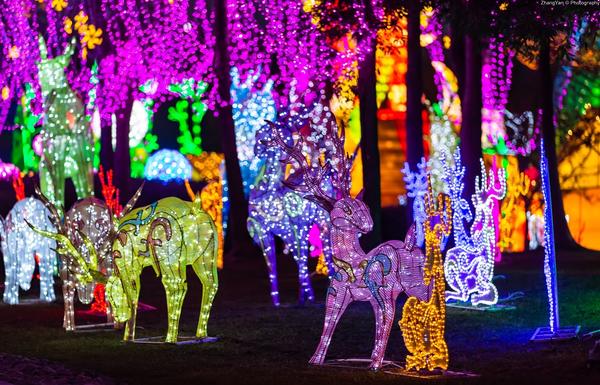Lantern Show with History in Mind Draws Visitors in Chengdu

Colorful deer-shaped lanterns are among the displays. [Photo provided to chinadaily.com.cn]
A museum held a lantern show depicting local farming customs dating back 3,000 years in Chengdu, Southwest China's Sichuan province, to celebrate the Lantern Festival on Tuesday.
"For many consecutive years, my wife and I have taken our daughter, a student, to the Jinsha Site Museum, which is only about 10 minutes' drive from my photo studio to celebrate the Lantern Festival. We like the lanterns there," said Luo Zhaoxiang, a photo studio owner in Chengdu.

A farmer spears a fish in a brook on the Chengdu Plain in ancient times in one of the lantern show displays. [Photo provided to chinadaily.com.cn]
To create a festive atmosphere for visitors during Spring Festival, the local government in Chengdu has sponsored a lantern fair since 2009 in the garden-like museum that covers nearly 29 hectares.
The current festival, which began on Feb 3 and ends on Wednesday, features Sichuan's history and how its ancient people lived.

A lantern display features farmers’ thatched cottages surrounded by bamboo on the Chengdu Plain in ancient times. [Photo provided to chinadaily.com.cn]
According to historical records, people lived on the Chengdu Plain about 5,000 years ago, farming and fishing. Visitors to the museum during the lantern fair can see lanterns showing ancient Sichuan people farming and fishing.

Lanterns portray a sacrificial ceremony on the Chengdu Plain in Southwest China's Sichuan province about 3,000 years ago. [Photo provided to chinadaily.com.cn]
The Chengdu Plain, one of the country's major farming areas, was the habitat of ancient Sichuan people and animals, like deer, thanks to its warm and humid climate.
"A flock of deer is kept in the Jinsha Site Museum all year 'round. After they visit the deer-shaped lanterns in the current lantern fair, they can see live deer," said Tao Xiaoli, an information officer with the museum.

A lantern show display includes a scene of ancient farmers’ peaceful life on the Chengdu Plain in Southwest China's Sichuan province. [Huang Zhiling/chinadaily.com.cn]
On Feb 8, 2001, builders working on an apartment construction site in Jinsha village in Chengdu found ivory and jade pieces among the piles of dirt.
Since then, archaeologists have excavated more than 10,000 precious relics dating back 3,000 years. They include gold, jade, bronze and stone wares, as well as elephant tusks and deer bones.

Colorful lights create a scene illustrating a sacrificial ceremony on the Chengdu Plain in Southwest China's Sichuan province about 3,000 years ago. [Photo provided to chinadaily.com.cn]
The sun bird in gold foil unearthed at the Jinsha Ruins is the symbol of China cultural heritage.
In 2007, the museum built on the site of the Jinsha Ruins opened to the public, housing relics unearthed there.
The deer bones came from deer killed for sacrificial ceremonies that were important in ancient Sichuan, said Zhu Zhangyi, an archaeologist in Chengdu.
